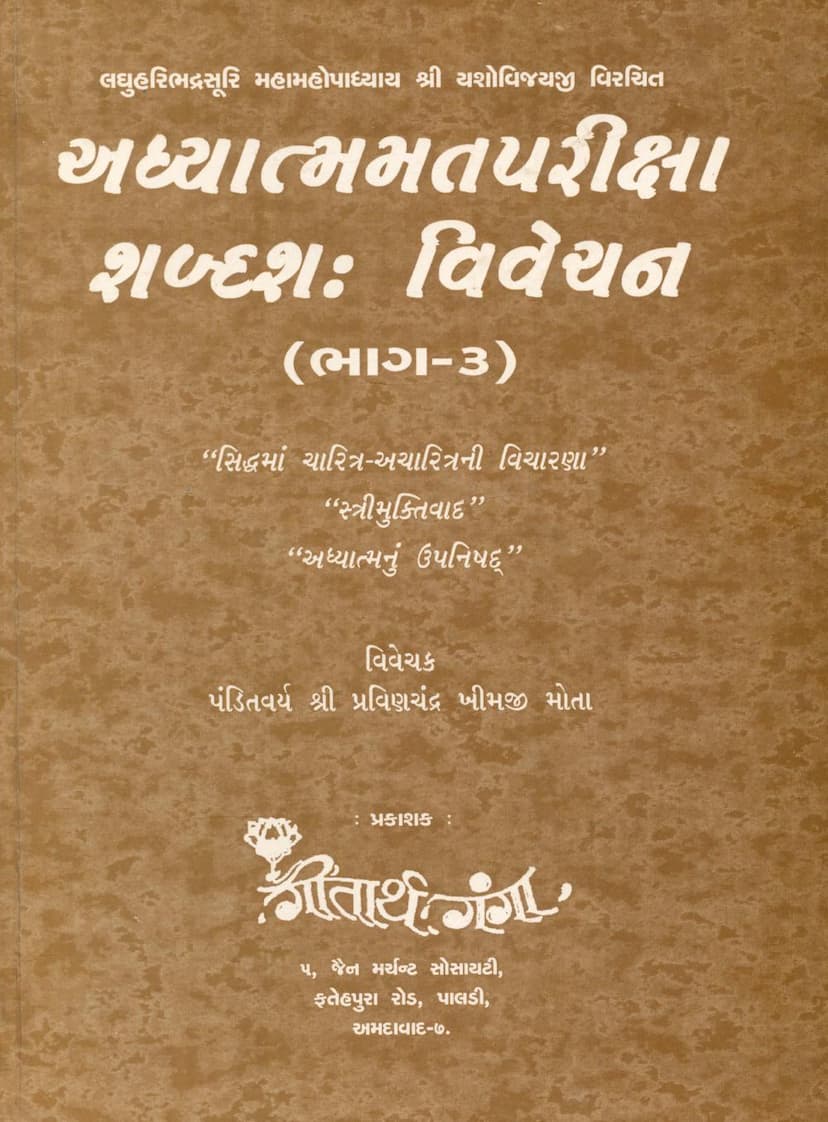Adhyatmamatpariksha Shabdasha Vivechan Part 03
Added to library: September 1, 2025

Summary
Here's a comprehensive summary of the provided Jain text, "Adhyatmamatpariksha Shabdasha Vivechan Part 03," authored by Pravinchandra K Mota and published by Gitarth Ganga:
This document is the third part of a detailed, word-by-word commentary on the Jain text "Adhyatmamatpariksha" (An Examination of the Doctrine of Spirituality) by the esteemed scholar Upadhyaya Shri Yashovijayji. This volume delves into several critical philosophical debates within Jainism, offering in-depth analysis and refutation of opposing views.
Key Themes and Discussions in Part 3:
-
The Nature of Conduct in Siddha (Liberated) Souls:
- The text thoroughly investigates whether liberated souls (Siddhas) possess conduct (Charitra) or not.
- It presents two main viewpoints:
- Siddhanta Paksha: This perspective, often associated with Digambara tradition, argues that Siddhas do not possess conduct. Their stance is based on scriptural statements like "Siddhe cho charitti, no aritti" (In the Siddha, there is conduct, but not non-conduct).
- Sampradaya Paksha: This perspective, generally aligned with Shvetambara tradition, asserts the presence of conduct in Siddhas.
- Upadhyaya Yashovijayji, through extensive reasoning and scriptural citations, meticulously discusses both these views, elaborating on the principles that support the existence of conduct in the Siddha state.
-
The Liberation of Women (Strimukti Vada):
- This section addresses the controversial topic of whether women can attain liberation.
- The text examines the viewpoint of Digambara and Adhyatmika (certain spiritualists) traditions, which generally deny liberation to women.
- The Digambara argument is rooted in their belief that external possessions (like clothing) are incompatible with perfect conduct, and since women cannot renounce clothing, they cannot attain perfect conduct and thus, liberation.
- Upadhyaya Yashovijayji counters this by demonstrating that religious implements are not considered possessions in the same way. He argues, with numerous logical arguments and scriptural references, that women are capable of attaining perfect conduct (Charitra) and can achieve liberation through the practice of the Three Jewels (Ratnatrayi).
-
The Ultimate Essence of Spirituality (Adhyatmano Upanishad):
- Following the detailed discussions on conduct in Siddhas and women's liberation, the text reveals the profound secret of spirituality.
- The author highlights that the highest secret of spirituality lies in diligently striving for the path of continence (Samyam) without negligence (Apramatta). This is presented as the supreme command of the Lord.
- The text explores the path to detachment (Vairagya), clarifying whether it arises from experiencing (Bhoga) or renouncing (Tyaga) pleasures. While acknowledging a Syadvada (multi-faceted perspective) on this, the book emphasizes the "Rajmarg" (royal path) of detachment through renunciation of enjoyments.
- The author's sharp intellect and logical prowess are evident in this profound subject matter.
- The ultimate essence of spirituality is further elucidated in another profound verse, stating that the instruction of Lord Jinanesha is to act in whatever way pleases and dissolves attachment and aversion (Raga-Dvesha). The entire scripture's word-by-word commentary is completed according to this conceptual division.
Commentary and Compilation Process:
- The commentary is meticulously prepared by Pandit Shri Pravinchandra Khimji Mota.
- The compiler expresses a personal aspiration that this study of spiritual texts will bring peace to his own ailing health, help him avoid Arta Dhyana (sorrowful meditation) during times of physical distress, and keep his mind steady in Dharma Dhyana (religious contemplation). The ultimate goal is Karma Nirjara (shedding of karma) and achieving the ultimate happiness of the soul.
- The compiler emphasizes the effort to make the profound concepts understandable, even if it involves repetition of the commentary's meaning for those unfamiliar with Sanskrit.
- The work of proofreading was significantly aided by Sadhviji Shri Hitaruchitaji M.S. and Shri Shantilal Shivlal Shah, for which they express gratitude.
- The compiler humbly requests forgiveness for any errors in interpretation or compilation due to their limited knowledge, seeking the blessings of the omniscient and the author's intent.
Publisher and Contributors:
- Publisher: Gitarth Ganga, Ahmedabad.
- Aadhesha (Blessings): Acharyadev Shrimad Vijay Ramchandra Surishwarji Maharaja (Vakhyan Vachaspati, Shasan Prabhavak) and the late Param Pujya Muniraj Shri Mohjitvijayji Maharaja (Pad-Darshan Vimarsh Vachaspati).
- Vivechanakar (Commentator): Panditvar Shri Pravinchandra Khimji Mota.
- Sankalan-Sanshodhanakarika (Compiler-Researcher): Sadhvi Shri Chandanbalashriji, disciple of Acharyadev Shrimad Vijay Mohoday Surishwarji M.S., and Acharyadev Shrimad Vijay Ramchandra Surishwarji M.S.
Overall Significance:
"Adhyatmamatpariksha Shabdasha Vivechan Part 03" is a scholarly work that continues the tradition of rigorous Jain philosophical discourse. It not only defends the doctrines of the Shvetambara tradition regarding the conduct of liberated souls and the liberation of women but also offers profound insights into the core principles of spirituality, emphasizing diligent effort in the path of continence as the ultimate secret. The commentary aims to make these intricate philosophical points accessible to spiritual seekers, fostering deeper understanding and practical application of Jain teachings.